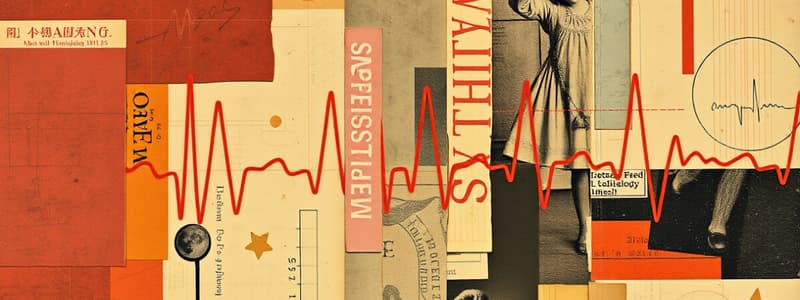Podcast
Questions and Answers
Which pulse site is located at the wrist?
Which pulse site is located at the wrist?
- Carotid
- Radial (correct)
- Femoral
- Brachial
Hypertension symptoms are usually apparent in chronic hypertension.
Hypertension symptoms are usually apparent in chronic hypertension.
False (B)
What is the diagnostic criterion for orthostatic hypotension?
What is the diagnostic criterion for orthostatic hypotension?
A dramatic drop in blood pressure upon standing
The normal range for adult body temperature is typically around _____ °F.
The normal range for adult body temperature is typically around _____ °F.
Match the blood pressure condition with its description:
Match the blood pressure condition with its description:
What measurement is affected by changes in blood volume and posture?
What measurement is affected by changes in blood volume and posture?
Pulse oximetry measures the amount of oxygen saturation in the blood.
Pulse oximetry measures the amount of oxygen saturation in the blood.
List one sign or symptom associated with cardiovascular impairment.
List one sign or symptom associated with cardiovascular impairment.
The normal pulse rate for an adult is between _____ beats per minute.
The normal pulse rate for an adult is between _____ beats per minute.
Which of the following tools is commonly used for measuring blood pressure?
Which of the following tools is commonly used for measuring blood pressure?
Flashcards are hidden until you start studying
Study Notes
Learner Objectives
- Identify locations for various pulse points: carotid, apical, brachial, radial, femoral, popliteal, posterior tibial, dorsalis pedis.
- Understand normal vs abnormal values for vital signs including body temperature, pulse rate, blood pressure, respiratory rate, body mass index (BMI), and pulse oximetry.
- Perform calculations and procedures for monitoring vital signs: pulse, blood pressure, respiratory rate, pulse oximetry, BMI, and ankle brachial index.
- Recognize symptoms associated with cardiovascular and respiratory impairments.
Vital Signs
- Vital signs (Cardinal signs) include body temperature, pulse, blood pressure, respiratory rate, and oxygen saturation.
Pulse Sites
- Major pulse sites are critical for assessing circulatory health and include various accessible locations on the body.
Blood Pressure (BP)
- Proper equipment and techniques are essential for accurate blood pressure measurements.
- Hypertension may be asymptomatic; transient symptoms can include headaches, dizziness, fatigue, palpitations, and nosebleeds.
- Orthostatic hypotension occurs when sudden changes in position lead to a drop in BP, causing dizziness, nausea, weakness, and potential fainting, especially after surgery or prolonged bed rest.
Respiratory Rate (RR)
- Understanding and monitoring respiratory rate is fundamental in assessing pulmonary function and overall health.
Gait Speed
- Gait speed assessments are important for evaluating mobility and potential health issues in patients. Further details are available in a separate handout.
Related Measures
- Monitoring techniques for vital signs may include various calculations and assessments to manage patient health effectively.
Studying That Suits You
Use AI to generate personalized quizzes and flashcards to suit your learning preferences.



